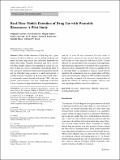Real-Time Mobile Detection of Drug Use with Wearable Biosensors: A Pilot Study
Author(s)
Carreiro, Stephanie; Smelson, David; Ranney, Megan; Hayes, Rashelle; Horvath, Keith J.; Boudreaux, Edwin D.; Boyer, Edward W.; Picard, Rosalind W.; ... Show more Show less
Download13181_2014_Article_439.pdf (538.0Kb)
OPEN_ACCESS_POLICY
Open Access Policy
Creative Commons Attribution-Noncommercial-Share Alike
Terms of use
Metadata
Show full item recordAbstract
While reliable detection of illicit drug use is paramount to the field of addiction, current methods involving self-report and urine drug screens have substantial limitations that hinder their utility. Wearable biosensors may fill a void by providing valuable objective data regarding the timing and contexts of drug use. This is a preliminary observational study of four emergency department patients receiving parenteral opioids and one individual using cocaine in a natural environment. A portable biosensor was placed on the inner wrist of each subject, to continuously measure electrodermal activity (EDA), skin temperature, and acceleration. Data were continuously recorded for at least 5 min prior to drug administration, during administration, and for at least 30 min afterward. Overall trends in biophysiometric parameters were assessed. Injection of opioids and cocaine use were associated with rises in EDA. Cocaine injection was also associated with a decrease in skin temperature. Opioid tolerance appeared to be associated with a blunted physiologic response as measured by the biosensor. Laterality may be an important factor, as magnitude of response varied between dominant and nondominant wrists in a single patient with bilateral wrist measurements. Changes in EDA and skin temperature are temporally associated with intravenous administration of opioids and cocaine; the intensity of response, however, may vary depending on history and extent of prior use.
Date issued
2014-10Department
Massachusetts Institute of Technology. Media Laboratory; Program in Media Arts and Sciences (Massachusetts Institute of Technology)Journal
Journal of Medical Toxicology
Publisher
Springer US
Citation
Carreiro, Stephanie et al. “Real-Time Mobile Detection of Drug Use with Wearable Biosensors: A Pilot Study.” Journal of Medical Toxicology 11.1 (2015): 73–79.
Version: Author's final manuscript
ISSN
1556-9039
1937-6995